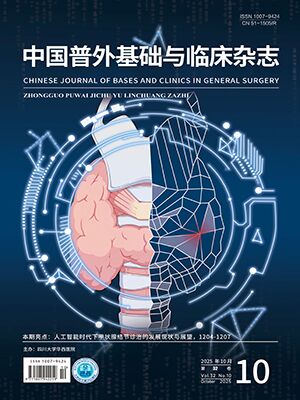| 1. |
?Piarroux M, Piarroux R, Giorgi R, et al. Clinical features and evolution of alveolar echinococcosis in France from 1982 to 2007: results of a survey in 387 patients. J Hepatol, 2011, 55(5): 1025-1033.
|
| 2. |
Vuitton DA, Zhang SL, Yang Y, et al. Survival strategy of Echino-coccus multilocularis in the human host. Parasitol Int, 2006: 55 Suppl: S51-S55.
|
| 3. |
Kademani D, Lewis JT, Lamb DH, et al. Angiogenesis and CD34 expression as a predictor of recurrence in oral squamous cell carcinoma. J Oral Maxillofac Surg, 2009, 67(9): 1800-1805.
|
| 4. |
Siemerink MJ, Klaassen I, Vogels IM, et al. CD34 marks angiogenic tip cells in human vascular endothelial cell cultures. Angiogenesis, 2012, 15(1): 151-163.
|
| 5. |
Feng LL, Liu BX, Zhong JY, et al. Effect of grape procyanidins on tumor angiogenesis in liver cancer xenograft models. Asian Pac J Cancer Prev, 2014, 15(2): 737-741.
|
| 6. |
Moon HS, Park WI, Sung SH, et al. Immunohistochemical and quantitative competitive PCR analyses of midkine and pleiotrophin expression in cervical cancer. Gynecol Oncol, 2003, 88(3): 289-297.
|
| 7. |
Namisaki T, Yoshiji H, Noguchi R, et al. The vascular endothelial growth factor (VEGF) receptor-2 is a major regulator of VEGF-mediated salvage effect in murine acute hepatic failure. J Angiogenes Res, 2010, 2: 16.
|
| 8. |
Ferrara N. The role of VEGF in the regulation of physiological and pathological angiogenesis. EXS, 2005, (94): 209-231.
|
| 9. |
Ferrara N. VEGF-A: a critical regulator of blood vessel growth. Eur Cytokine Netw, 2009, 20(4): 158-163.
|
| 10. |
Weidner N, Folkman J, Pozza F, et al. Tumor angiogenesis: a new significant and independent prognostic indicator in early-stage breast carcinoma. J Natl Cancer Inst, 1992, 84(24): 1875-1887.
|
| 11. |
Cui XB, Pang XL, Li S, et al. Elevated expression patterns and tight correlation of the PLCE1 and NF-κB signaling in Kazakh patients with esophageal carcinoma. Med Oncol, 2014, 31(1): 791.
|
| 12. |
Yang P, Yuan W, He J, et al. Overexpression of EphA2, MMP-9, and MVD-CD34 in hepatocellular carcinoma: Implications for tumor progression and prognosis. Hepatol Res, 2009, 39(12): 1169-1177.
|
| 13. |
Chiang IT, Liu YC, Wang WH, et al. Sorafenib inhibits TPA-induced MMP-9 and VEGF expression via suppression of ERK/NF-κB pathway in hepatocellular carcinoma cells. In Vivo, 2012, 26(4): 671-681.
|
| 14. |
Takino J, Yamagishi S, Takeuchi M. Glycer-AGEs-RAGE signaling enhances the angiogenic potential of hepatocellular carcinoma by upregulating VEGF expression. World J Gastroenterol, 2012, 18(15): 1781-1788.
|
| 15. |
李俊, 姚秉禮, 欒梅香, 等.肝泡狀棘球蚴病89例的治療探討.中華普通外科雜志, 2000, 15(11): 41-42.
|
| 16. |
荔童, 張示杰.血管新生在肝泡球蚴浸潤性生長中的作用.中國人獸共患病學報, 2014, 30(10): 1071-1074.
|
| 17. |
魏曉麗, 丁劍冰, 許晏, 等.小鼠感染泡球蚴后細胞因子水平的變化.中國寄生蟲學與寄生蟲病雜志, 2004, 22(6): 361-364.
|
| 18. |
蔣次鵬.泡球蚴病研究回顧.中國寄生蟲病防治雜志, 1998, 11(1): 65-68.
|
| 19. |
Nagai T, Arao T, Furuta K, et al. Sorafenib inhibits the hepatocyte growth factor-mediated epithelial mesenchymal transition in hepatocellular carcinoma. Mol Cancer Ther, 2011, 10(1): 169-177.
|
| 20. |
張龍, 張示杰, 曹玉文, 等.骨橋蛋白與肝泡型棘球蚴轉移的相關性研究.中國寄生蟲學與寄生蟲病雜志, 2011, 29(1): 33-36.
|
| 21. |
Hirama M, Takahashi F, Takahashi K, et al. Osteopontin overproduced by tumor cells acts as a potent angiogenic factor contributing to tumor growth. Cancer Lett, 2003, 198(1): 107-117.
|
| 22. |
吳何興, 吳向未, 連文波, 等.抗骨橋蛋白抗體對沙鼠肝多房棘球蚴組織周圍血管生成的影響.中國病原生物學雜志, 2014, 9(10): 894-897.
|
| 23. |
Vuitton DA, Gottstein B. Echinococcus multilocularis and its intermediate host: a model of parasite-host interplay. J Biomed Biotechnol, 2010, 2010: 923193.
|
| 24. |
Guerret S, Vuitton DA, Liance M, et al. Echinococcus multilocularis: relationship between susceptibility/resistance and liver fibrogenesis in experimental mice. Parasitol Res, 1998, 84(8): 657-667.
|
| 25. |
王靜, 任波, 劉文亞, 等.肝臟泡球蚴病CT灌注成像與微血管密度及血管內皮生長因子的相關性分析.中華放射學雜志, 2011, 45(11): 1036-1039.
|
| 26. |
McManus DP, Zhang W, Li J, et al. Echinococcosis. Lancet, 2003, 362(9392): 1295-1304.
|
| 27. |
桑澤杰, 朱帝文, 紀衛政, 等.肝動脈灌注貝伐單抗治療大鼠肝泡狀棘球蚴病后血管內皮生長因子的動態變化.介入放射學雜志, 2014, 23(6): 516-519.
|




